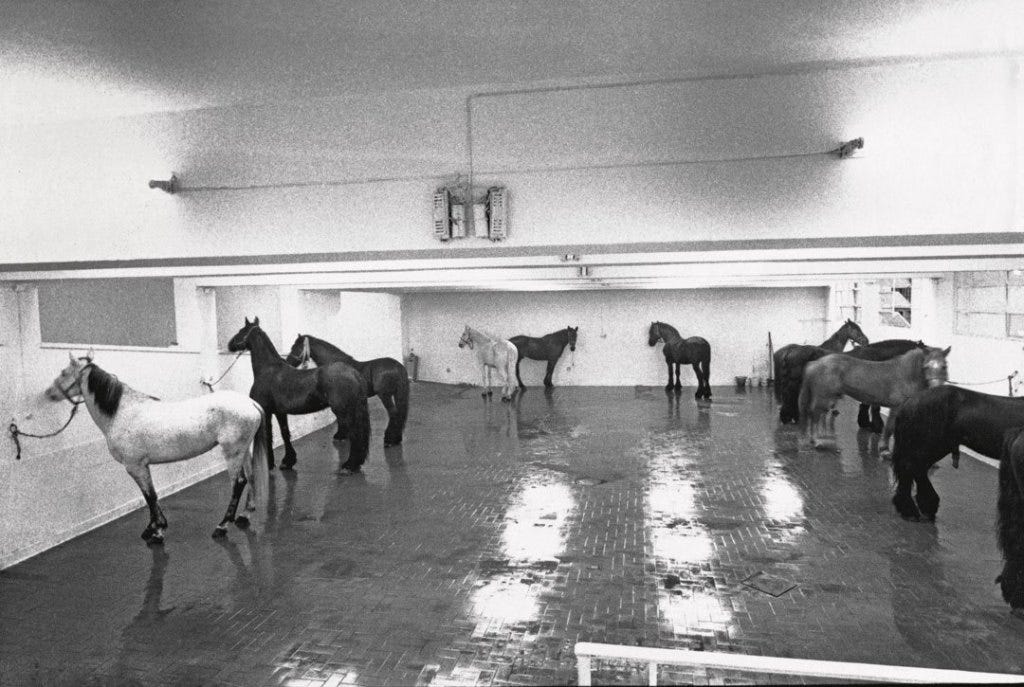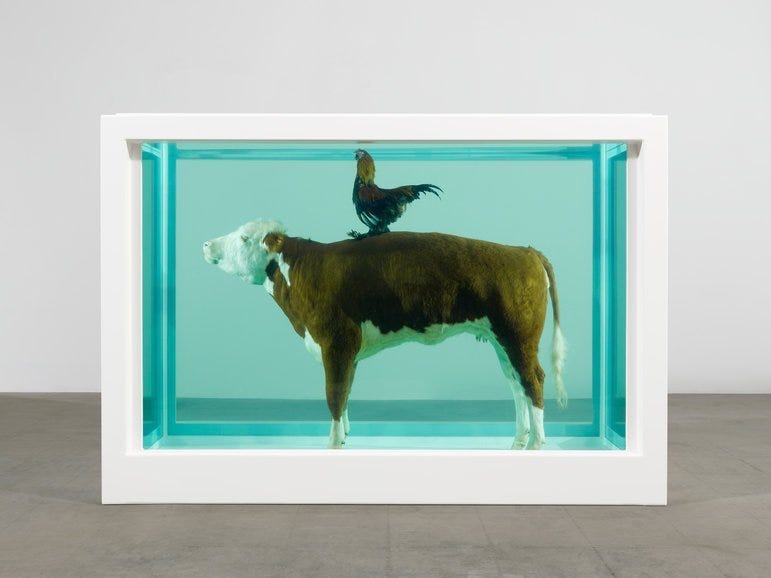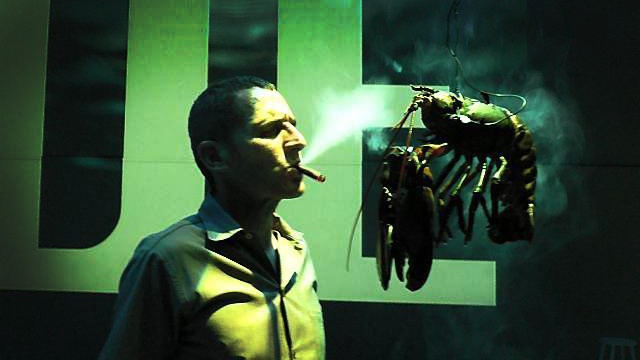Art is not subject to rules, it is free, but does it mean that it has no borders? The use of living and dead animals in art has become a popular phenomenon, both in performances and installations, theatre, film, and advertising. Is every form of “using” an animal already a norm, or are there any ethical limits to art?
Bloody theater of dead animals
In recalling the actions of the Viennese Shareholders, who used not only their bodies but also the bodies of animals in their performances, I am disgusted.
Let us recall that Hermann Nitsch, the master of disgust and some of his companions, lived with animals, defiled their bodies, sacrificed themselves, and finally, under the name of the Theater of the Orgies of Mysteries, poured blood on themselves in the vicinity of a depraved animal’s body. All under the supervision of a veterinary institute. Volunteers could take part in the performance after buying a ticket.
Jannis Kounellis, associated with Arte Povera since the 1960s, brought a dozen live horses to the Gavin Brown enterprise to reconstruct his innovative work, Without a Title (12 Horses; 1969). In 2006 Banksy used a live elephant as a metaphor and painted it with paint. Meanwhile, someone noticed that it might be unethical and ordered the elephant to be brushed out of the paint.

Every day Damien Hirst stirs up the anger of pro-animal activists by using sharks, farm animals, and in extreme conditions even killing them in front of the audience.

Where, then, is the boundary of any limit on animals in art?
A law to protect animals?
If it is normal for many to use animals in a circus, why not be part of an installation? Why should we be outraged by the pyramid of Kozyra’s animals, after all, they are dead animals? To understand the problem, one should consider whether we have already done insufficient evil by compressing pigs, cows, hens, fish, insects in production halls, taking away their dignity, treating them as the modes of a food-producing machine.
Today, by closing animals behind walls, we have closed our eyes of society.
Because what is so carefully hidden does not show us the process, it shows us the effect, the meat. Effective advertising propaganda knocks out of our head the awareness of harming animals, the sight of blood, mutilated bodies, the smell of fear, terrified eyes, all of this has been hidden.
Art should show what the industry is trying to hide.
It should reinterpret the animal, show its history, as it showed slavery and all social problems, because „meatholism” is a social problem, affects the economy, our health, our planet and perhaps, instead of treating another animal as an exhibit, we should start showing their life, feelings, and suffering?
In the case of Guillermo Vargas, who tied a skinny dog in an art gallery with no access to water and watched how people did not react to his suffering, or in the case of the film “Flisacy” where the director decided to film burning animals alive, there is no doubt about the abuse of animals, there is no explanation for these acts, no interpretation that would move the viewers, make them aware of the problem of not seeing these animals.
Each of these cases should be subject to legal protection and appropriate punishment.
Some, in a rather controversial way, want to prove to us that the killing of animals is a universal norm, inherent in human life, and at the same time, as in the case of Rodrigo Garcia, they claim that perhaps their work will persuade us to give up meat.
 Rodrigo Garcia
Rodrigo GarciaDuring the play “Accidents: Kill to eat”, performer Rodrigo Garcia pierces a live lobster on stage. The lobster hung on a rope has a microphone attached so that the audience can hear his heartbeat, feel his fear, and finally hear the dead silence.
The artist did not see anything wrong with it (even though he was reported to the Polish prosecutor’s office for animal abuse), the next day he threw hamsters into the aquarium during the next performance. The performance was interrupted and the animals were saved from drowning by activists.
In the cases described above, we can define the boundaries of art, where the law sets them, but the law in each country regulates the behavior towards animals differently.
In Poland, it is regulated by the State Veterinary Inspection, the same Inspection gave permission to kill lobster, on the stage in Wrocław, I suspect that if it were a hen, or perhaps even a pig, the decision would be similar, because farm animals die for us every day, every second, only on a different stage.
Setting the boundaries of art?
In 2019, the College Art Association (the principal organization in the United States for visual arts professionals, art historians, etc.) developed guidelines for artists using animals in art. Along with the warrant: “No work of art should cause physical or mental pain or suffering to an animal during its creation.
One of the questions to the artists was “Did you do some research on the biology of an animal (used in art) to understand its physiognomy and emotional experience?
In his works, Pierre Huyghe shows a dog named Human wandering around the gallery, bees doing their job, ants wandering around the walls of the museum. Few people pay attention to their use in art, because they seem to hate it.
A dog named “human” was supposedly examined by an organization dealing with animal rights and allowed to perform in a gallery during an exhibition.
She is not forced to stay in the gallery all the time, the only thing expected of her is to stay within the boundaries of the interior of the museum. And although this case, like the 12 horses in the gallery, seems to be not harmful to the animal, this question of suffering and discomfort is important for both artists and the audience, because the suffering of the animal can be difficult to notice.
Yvette Watt, a lecturer at the University of Tasmania, who focuses on the study of animals in art, notes that changing the environment of an animal’s natural environment and introducing it into another environment, and changing its care, can do great harm just because the animal does not show fear, not necessarily mean it is happy, or does not experience uncomfortable stimuli that result in stress or even death.
The same lack of observation of suffering is hiding behind the farmers in industrial breeding because the fact that a pig locked in a pen does not produce a pathetic flower all the time does not mean that it does not suffer. This animal, which is often smarter than a three-year-old child, has been objectified, mutilated and reduced to a single role in the birth of new young pigs for fattening for meat.
How did it happen that the world of art became a menagerie and how does it want to reach an ethical consensus by using animals in art?
If people consent to the exploitation of animals in a circus, in industrial breeding, can they accept animals in an art gallery as well?
Today, almost every ethically incorrect exhibition is exposed to demonstrations by activists and the activities of the Peta organization.
People more and more often notice the problem and report violations themselves. Since Katarzyna Kozyra has already started a discussion on ethics in Poland and the use of animals in art with her Pyramid of Animals, we could continue this discussion and how some countries could introduce guidelines for the use of non-human animals in uncomfortable conditions for them, banning the public killing of them for any purpose, even the unnoticed and objectified farm animals.
And while even carnivores may be surprised at killing animals for the sake of the arts (despite consuming the meat they obtain from them), they have the right to question such actions. In both cases, the animal is reduced to inanimate matter, an object, in this case like clay or paint, in industrial breeding a machine for producing meat.
According to anthropocentric theories, we permit ourselves to harm non-human animals, to make the Earth subordinate to us.
Empathy dies very quickly, turning into indifference. It is more convenient for us not to think than to see evil. Artists have free will, free choice, they can decide how to create art, they can and should follow the rules of ethics.
Art could and should lead to reflection on today’s world, which we humans have destroyed. It is such a “beautiful work” of catastrophe, like the one from Hieronymus Bosch, isn’t it worth reinterpreting it?
It is a wonderful moment to use art to introduce social changes, to create works that affect the audience. It no longer causes only emotions, goosebumps or fainting, but leads to a change of behavior in society.
It is understandable for everyone and legible. And although artists are doing it well, organizing exhibitions under the supervision and acceptance of the Peta organization, let’s leave the animals alone, nowadays few animals can live free, without human intervention, without harm.
Let us set at least one good border.
Read more on my blog: https://calkiemnudnezycie.pl/do-insects-feel-pain/
https://www.artsy.net/article/artsy-editorial-animals-art

